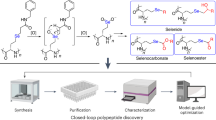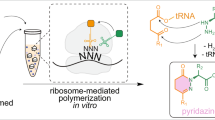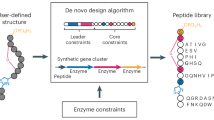Abstract
The main biopolymers in nature are oligonucleotides and polypeptides. However, naturally occurring peptide–nucleobase hybrids are rare. Here we report the characterization of the founding member of a class of peptide–nucleobase hybrid natural products with a pyrimidone motif from a widely distributed ribosomally synthesized and post-translationally modified (RiPP) biosynthetic pathway. This pathway features two steps where a heteromeric RRE–YcaO–dehydrogenase complex catalyzes the formation of a six-membered pyrimidone ring from an asparagine residue on the precursor peptide, and an acyl esterase selectively recognizes this moiety to cleave the C-terminal follower peptide. Mechanistic studies reveal that the pyrimidone formation occurs in a substrate-assisted catalysis manner, requiring a His residue in the precursor to activate asparagine for heterocyclization. Our study expands the chemotypes of RiPP natural products and the catalytic scope of YcaO enzymes. This discovery opens avenues to create artificial biohybrid molecules that resemble both peptide and nucleobase, a modality of growing interest.

This is a preview of subscription content, access via your institution
Access options
Access Nature and 54 other Nature Portfolio journals
Get Nature+, our best-value online-access subscription
$32.99 / 30 days
cancel any time
Subscribe to this journal
Receive 12 print issues and online access
$259.00 per year
only $21.58 per issue
Buy this article
- Purchase on SpringerLink
- Instant access to full article PDF
Prices may be subject to local taxes which are calculated during checkout






Similar content being viewed by others
Data availability
All data supporting the findings of this study are presented in the main text and Supplementary Information file. NCBI (https://www.ncbi.nlm.nih.gov/) accessions and PDB (https://www.rcsb.org/) codes are referenced in the Supplementary Information file, and publicly accessible on the respective websites. Source data are provided with this paper. mzML versions of the LC–MS/MS files used for metabolomics are available from the MassIVE repository with accession MSV000094563 (ftp://massive.ucsd.edu/v07/MSV000094563/). Data is available from the corresponding author upon request.
References
Runnels, C. M. et al. Folding, assembly, and persistence: the essential nature and origins of biopolymers. J. Mol. Evol. 86, 598–610 (2018).
Stephanopoulos, N. Peptide-oligonucleotide hybrid molecules for bioactive nanomaterials. Bioconjugate Chem. 30, 1915–1922 (2019).
Freitag, J. S. et al. Integration of functional peptides into nucleic acid-based nanostructures. Nanoscale 15, 7608–7624 (2023).
Habibi, N., Kamaly, N., Memic, A. & Shafiee, H. Self-assembled peptide-based nanostructures: smart nanomaterials toward targeted drug delivery. Nano Today 11, 41–60 (2016).
Swenson, C. S. & Heemstra, J. M. Peptide nucleic acids harness dual information codes in a single molecule. Chem. Commun. 56, 1926–1935 (2020).
MacCulloch, T., Buchberger, A. & Stephanopoulos, N. Emerging applications of peptide-oligonucleotide conjugates: bioactive scaffolds, self-assembling systems, and hybrid nanomaterials. Org. Biomol. Chem. 17, 1668–1682 (2019).
Pomplun, S., Gates, Z. P., Zhang, G. W., Quartararo, A. J. & Pentelute, B. L. Discovery of nucleic acid binding molecules from combinatorial biohybrid nucleobase peptide libraries. JACS 142, 19642–19651 (2020).
He, Y. D. et al. Selective targeting of guanine-vacancy-bearing G-quadruplexes by G-quartet complementation and stabilization with a guanine–peptide conjugate. JACS 142, 11394–11403 (2020).
Swenson, C. S., Velusamy, A., Argueta-Gonzalez, H. S. & Heemstra, J. M. Bilingual peptide nucleic acids: encoding the languages of nucleic acids and proteins in a single self-assembling biopolymer. J. Am. Chem. Soc. 141, 19038–19047 (2019).
Chen, Z., Lichtor, P. A., Berliner, A. P., Chen, J. C. & Liu, D. R. Evolution of sequence-defined highly functionalized nucleic acid polymers. Nat. Chem. 10, 420–427 (2018).
Montalbán-López, M. et al. New developments in RiPP discovery, enzymology and engineering. Nat. Prod. Rep. 38, 130–239 (2021).
Ongpipattanakul, C. et al. Mechanism of action of ribosomally synthesized and post-translationally modified peptides. Chem. Rev. 122, 14722–14814 (2022).
Cao, L., Do, T. & Link, A. J. Mechanisms of action of ribosomally synthesized and posttranslationally modified peptides (RiPPs). J. Ind. Microbiol. Biotechnol. 48, kuab005 (2021).
Miller, R. D. et al. Computational identification of a systemic antibiotic for gram-negative bacteria. Nat. Microbiol. 7, 1661–1672 (2022).
Imai, Y. et al. A new antibiotic selectively kills gram-negative pathogens. Nature 576, 459–464 (2019).
Burkhart, B. J., Schwalen, C. J., Mann, G., Naismith, J. H. & Mitchell, D. A. YcaO-dependent posttranslational amide activation: biosynthesis, structure, and function. Chem. Rev. 117, 5389–5456 (2017).
Arnison, P. G. et al. Ribosomally synthesized and post-translationally modified peptide natural products: overview and recommendations for a universal nomenclature. Nat. Prod. Rep. 30, 108–160 (2013).
Pei, Z. F., Zhu, L. Y. & Nair, S. K. Core-dependent post-translational modifications guide the biosynthesis of a new class of hypermodified peptides. Nat. Commun. 14, 7734 (2023).
Dunbar, K. L., Tietz, J. I., Cox, C. L., Burichart, B. J. & Mitchell, D. A. Identification of an auxiliary leader peptide-binding protein required for azoline formation in ribosomal natural products. JACS 137, 7672–7677 (2015).
Dunbar, K. L., Melby, J. O. & Mitchell, D. A. YcaO domains use ATP to activate amide backbones during peptide cyclodehydrations. Nat. Chem. Biol. 8, 569–575 (2012).
Travin, D. Y. et al. Biosynthesis of translation inhibitor klebsazolicin proceeds through heterocyclization and N-terminal amidine formation catalyzed by a single YcaO enzyme. JACS 140, 5625–5633 (2018).
Schwalen, C. J. et al. In vitro biosynthetic studies of bottromycin expand the enzymatic capabilities of the YcaO superfamily. JACS 139, 18154–18157 (2017).
Franz, L., Adam, S., Santos-Aberturas, J., Truman, A. W. & Koehnke, J. Macroamidine formation in bottromycins is catalyzed by a divergent YcaO enzyme. JACS 139, 18158–18161 (2017).
Liu, A. D. et al. Functional elucidation of TfuA in peptide backbone thioamidation. Nat. Chem. Biol. 17, 585–592 (2021).
Mahanta, N., Liu, A. D., Dong, S. H., Nair, S. K. & Mitchell, D. A. Enzymatic reconstitution of ribosomal peptide backbone thioamidation. Proc. Natl. Acad. Sci. USA 115, 3030–3035 (2018).
Clark, K. A. & Seyedsayamdost, M. R. Bioinformatic atlas of radical SAM enzyme-modified RiPP natural products reveals an isoleucine–tryptophan crosslink. JACS 144, 17876–17888 (2022).
Zheng, Y. W. & Nair, S. K. YcaO-mediated ATP-dependent peptidase activity in ribosomal peptide biosynthesis. Nat. Chem. Biol. 19, 111–119 (2023).
Russell, A. H., Vior, N. M., Hems, E. S., Lacret, R. & Truman, A. W. Discovery and characterisation of an amidine-containing ribosomally-synthesised peptide that is widely distributed in nature. Chem. Sci. 12, 11769–11778 (2021).
Li, Y. M., Milne, J. C., Madison, L. L., Kolter, R. & Walsh, C. T. From peptide precursors to oxazole and thiazole-containing peptide antibiotics: Microcin B17 synthase. Science 274, 1188–1193 (1996).
Dunbar, K. L. et al. Discovery of a new ATP-binding motif involved in peptidic azoline biosynthesis. Nat. Chem. Biol. 10, 823–829 (2014).
Jumper, J. et al. Highly accurate protein structure prediction with AlphaFold. Nature 596, 583–589 (2021).
Koehnke, J. et al. Structural analysis of leader peptide binding enables leader-free cyanobactin processing. Nat. Chem. Biol. 11, 558–563 (2015).
Ghilarov, D. et al. Architecture of microcin B17 synthetase: an octameric protein complex converting a ribosomally synthesized peptide into a DNA gyrase poison. Mol. Cell 73, 749–762 (2019).
Dong, S. H., Liu, A., Mahanta, N., Mitchell, D. A. & Nair, S. K. Mechanistic basis for ribosomal peptide backbone modifications. ACS Cent. Sci. 5, 842–851 (2019).
Bewley, K. D. et al. Capture of micrococcin biosynthetic intermediates reveals C-terminal processing as an obligatory step for in vivo maturation. Proc. Natl Acad. Sci. USA 113, 12450–12455 (2016).
Bresler, M. M., Rosser, S. J., Basran, A. & Bruce, N. C. Gene cloning and nucleotide sequencing and properties of a cocaine esterase from Rhodococcus sp strain MB1. Appl. Environ. Microbiol. 66, 904–908 (2000).
Larsen, N. A. et al. Crystal structure of a bacterial cocaine esterase. Nat. Struct. Mol. Biol. 9, 17–21 (2002).
Zhang, M. et al. Biosynthesis of C-nucleoside antibiotics in actinobacteria: recent advances and future developments. Micro. Cell Fact. 21, 2 (2022).
Shiraishi, T. & Kuzuyama, T. Recent advances in the biosynthesis of nucleoside antibiotics. J. Antibiot. (Tokyo) 72, 913–923 (2019).
Wang, L. Y. et al. Glycopeptide antitumor antibiotic zorbamycin from Streptomyces flavoviridis ATCC 21892: strain improvement and structure elucidation. J. Nat. Prod. 70, 402–406 (2007).
Galm, U. et al. Antitumor antibiotics: bleomycin, endiynes, and mitomycin. Chem. Rev. 105, 739–758 (2005).
Shen, B. et al. Cloning and characterization of the bleomycin biosynthetic gene cluster from Streptomyces verticillus ATCC15003. J. Nat. Prod. 65, 422–431 (2002).
Du, L. C., Sánchez, C., Chen, M., Edwards, D. J. & Shen, B. The biosynthetic gene cluster for the antitumor drug bleomycin from Streptomyces verticillus ATCC15003 supporting functional interactions between nonribosomal peptide synthetases and a polyketide synthase. Chem. Biol. 7, 623–642 (2000).
Dall’Acqua, W. & Carter, P. Substrate-assisted catalysis: molecular basis and biological significance. Protein Sci. 9, 1–9 (2000).
Ekici, Ö. D., Paetzel, M. & Dalbey, R. E. Unconventional serine proteases: variations on the catalytic Ser/His/Asp triad configuration. Protein Sci. 17, 2023–2037 (2008).
Radisky, E. S., Lee, J. M., Lu, C. J. K. & Koshland, D. E. Insights into the serine protease mechanism from atomic resolution structures of trypsin reaction intermediates. Proc. Natl Acad. Sci. USA 103, 6835–6840 (2006).
Cogan, D. P. et al. Structure and mechanism for iterative amide N-methylation in the biosynthesis of channel-forming peptide cytotoxins. Proc. Natl Acad. Sci. USA 119, e2116578119 (2022).
Lizak, C., Gerber, S., Numao, S., Aebi, M. & Locher, K. P. X-ray structure of a bacterial oligosaccharyltransferase. Nature 474, 350–355 (2011).
Pei, Z. F., Zhu, L., Sarksian, R., van der Donk, W. A. & Nair, S. K. Class V lanthipeptide cyclase directs the biosynthesis of a stapled peptide natural product. J. Am. Chem. Soc. 144, 17549–17557 (2022).
Wang, M. X. et al. Sharing and community curation of mass spectrometry data with Global Natural Products Social Molecular Networking. Nat. Biotechnol. 34, 828–837 (2016).
Acknowledgements
This work was supported by the National Institutes of Health (GM079038 to S.K.N.) and the Biotechnology and Biological Sciences Research Council via an institute strategic program grant (BB/X01097X/1) and research grant (BB/V016024/1) to A.W.T. and N.M.V. The Bruker UltrafleXtreme MALDI-TOF/TOF mass spectrometer was purchased in part with a grant from the National Institutes of Health (S10RR027109A). We thank J.S. Griffitts of Department of Microbiology and Molecular Biology at Brigham Young University for providing the DNA plasmids for the production of tclE/tclI/tclJ/tclN.
Author information
Authors and Affiliations
Contributions
Z.P. and S.K.N. designed the studies. Z.P. performed the experiments, and L.Z. acquired and interpreted the NMR data. N.M.V. and A.W.T. performed the metabolic analysis. All authors analyzed data and assisted in the writing and editorial process. S.K.N. conceived and supervised the project.
Corresponding author
Ethics declarations
Competing interests
The authors declare no competing interests.
Peer review
Peer review information
Nature Chemical Biology thanks Somayah Elsayed and the other, anonymous reviewer(s) for their contribution to the peer review of this work.
Additional information
Publisher’s note Springer Nature remains neutral with regard to jurisdictional claims in published maps and institutional affiliations.
Supplementary information
Supplementary Information
Supplementary Methods, Supplementary Figs. 1–40, Supplementary Tables 1–6.
Supplementary Data 1
Supporting data for Supplementary Fig. 28.
Rights and permissions
Springer Nature or its licensor (e.g. a society or other partner) holds exclusive rights to this article under a publishing agreement with the author(s) or other rightsholder(s); author self-archiving of the accepted manuscript version of this article is solely governed by the terms of such publishing agreement and applicable law.
About this article
Cite this article
Pei, ZF., Vior, N.M., Zhu, L. et al. Biosynthesis of peptide–nucleobase hybrids in ribosomal peptides. Nat Chem Biol 21, 143–154 (2025). https://doi.org/10.1038/s41589-024-01736-9
Received:
Accepted:
Published:
Issue date:
DOI: https://doi.org/10.1038/s41589-024-01736-9
This article is cited by
-
Pseudokinases can catalyse peptide cyclization through thioether crosslinking
Nature Chemistry (2025)



